Review: 2015 Suzuki RM-Z450
Suzuki updates its 2015 RM-Z450 with improvements to its chassis and suspension
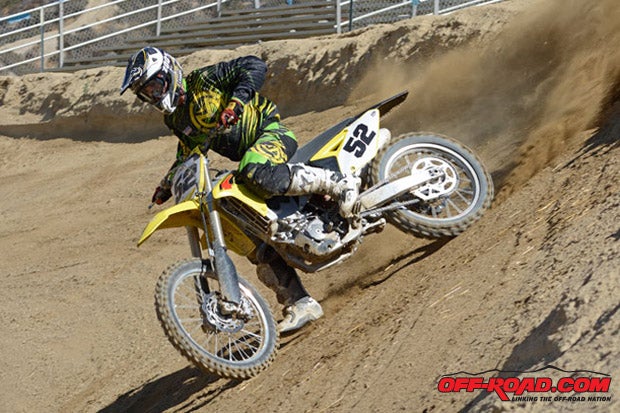
For the past few seasons, Suzuki’s RM-Z450 has been renowned for its fantastic handling if not for 450cc class-topping horsepower. With the rumor that newly crowned Lucas Oil AMA 450cc Motocross Champion Ken Roczen will be leaving Red Bull KTM to join the Yoshimura Suzuki team for the 2015 season, there is a lot at stake for Suzuki next season, so we expected the 2015 RM-Z450 to be faster and better than the 2014 version.
After swinging a leg over the 2015 model, we think it is faster and better, although not the way we figured that it would be.
For starters, internal mechanical changes to the RM-Z450’s fuel-injected, DOHC, 449cc four-stroke single-cylinder engine are relatively minor and not at all geared toward a major power increase as we anticipated. Instead, Suzuki engineers remapped the 450’s ignition and Keihin fuel injection, which utilizes a 44mm throttle body with a 12-hole fuel injector, to reshape the powerband with an emphasis on more low-end and mid-range grunt from the big bore/short-stroke (96.0 x 62.1mm) engine. Other changes included a redesigned muffler, although this was done more to keep the RM-Z in compliance with AMA sound regulations than to make power.
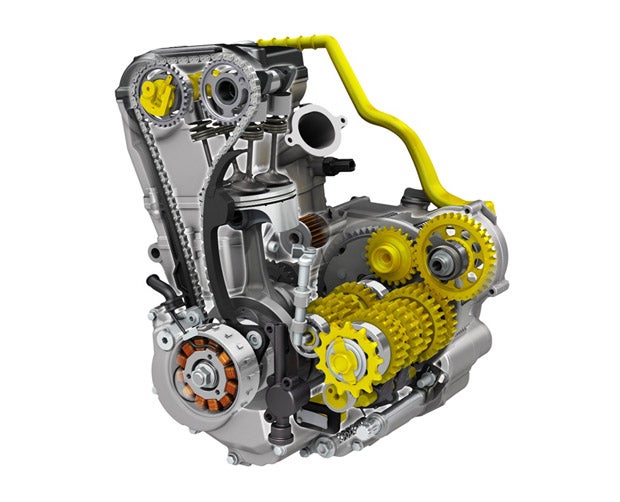
However, beyond the nuts and bolts, Suzuki has significantly stepped up the RM-Z450’s game by incorporating a new technology, the Suzuki Holeshot Assist Control (SHAC) system, to give the RM-Z450 a better chance at garnering the holeshot. The SHAC features two modes that alter ignition timing. In A Mode, the RM-Z retards the ignition to minimize wheel slip in hard-packed or slippery conditions, while B Mode offers more aggressive mapping for when starting gate conditions are conducive to more traction. Once out of the hole, the SHAC returns the ignition timing to the stock mapping after 1.2 seconds or once the rider engages third gear. The system is engaged by a button on the left-side handlebar, and it can be completely disengaged if conditions warrant it.
The RM-Z450 not only gets off the starting line better, but it is now easier to fire up as well, thanks to a redesign of its kick-starting gears. Suzuki already tackled this issue on the 2014 model by reprogramming its Electronic Control Module (ECM) to retard the ignition and eliminate an unwanted extra spark that was being thrown out during the exhaust stroke. The spark was igniting unburned residual gases in the combustion chamber and made starting a dicey propostion—not a good thing if you’re quickly trying to get back in the race after stalling or crashing. The new ECM appeared to help, as we had no trouble getting the 2014 to start, but apparently that wasn’t good enough for Suzuki. For 2015, the RM-Z450 also gets a 30mm longer kickstart lever and a revised kickstart idler gear along with an updated de-compression system and a redesigned exhaust camshaft to make starting the bike even easier. Suzuki officials are so proud of these changes that they claim the 450 can now be started by hand even when hot, and we can report that even a half-hearted boot is enough to get the big motor roaring to life.
But is it faster? Not in terms of outright power output, although our expert test rider, Ryan Abbatoye, still applauded the 2014 RM-Z450’s overall engine character. The RM-Z is far from slow, and all but a top-level Pro would have a hard time riding it to its potential, but Abbatoye is Pro, and he noted that fast and aggressive riders might still wish for improvement, particularly down low. Similar to the power character of the RM-Z250, the 450 is linear and responsive everywhere, but it really likes to be kept in the middle of the powerband for maximum effect on the track. Abbatoye found that short-shifting its slick five-speed transmission is the key to success because the 450 engine tends to run through its rpm range and kiss the rev limiter rather quickly on the track. The RM-Z450 boasts easy-riding power, but more low-end torque and a broader pull would be welcome.
Our best results at the track were obtained by swapping to the “fast” ECU coupler, which delivers a richer fuel setting throughout the rev range. Suzuki’s coupler system makes altering the RM-Z450’s powerband easy, and a swap takes mere seconds to complete. Simply unplug one coupler and plug-in a new one, and you’re ready to get back on the track.
Once we left the track, we put the RM-Z450 on the dyno, where it produced 49.5 peak rear-wheel horsepower at 8750 rpm, with 31.53 lb.-ft. of torque at 8000 rpm. The Suzuki maintained 30 lb.-ft. of torque from 6500 rpm to 8500 rpm, proving that it is a midrange monster. The numbers and the torque curve show that the RM-Z is strong, but it isn’t the strongest open-class engine in the class, and it makes its best power right where we thought it did.
One other improvement has been made to the cooling system, and the change should help the RM-Z450 maintain its peak power longer over the course of a moto. Suzuki engineers rerouted the coolant between the right and left radiator halves, and a new water-pump cover and hose connection direct coolant directly into the water-pump. The company claims that the RM-Z450’s coolant system is 16 percent more efficient because of it.
Peak power isn’t everything, especially in an open-class motocross machine—just ask some of Suzuki’s competition. Sure, holeshots are a big help, but wrestling a big-bore machine around the track takes a lot of energy, and for 95 percent of the RM-Z’s potential customers, arm-yanking power is more of a handicap than an advantage. Handling is just as crucial to overall performance, and the Suzuki RM-Z450 is famous for its precise handling. It can handle berms, sweepers and off-cambers like it is on rails, and it excels in loam or hardpack conditions. No matter what you throw at it, the RM-Z’s steering remains light and accurate, and its twin-spar aluminum chassis retains rock-solid stability in fast chop as well.
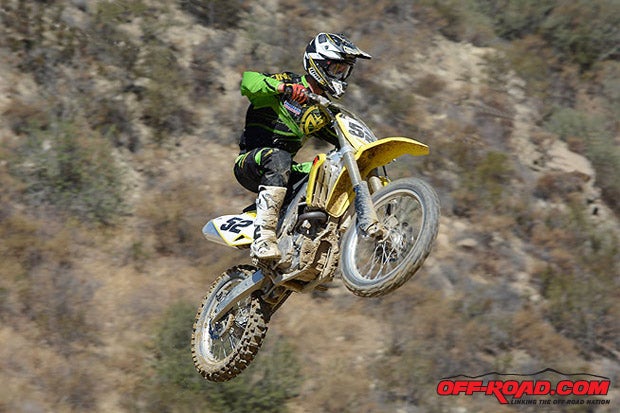
The key to the RM-Z’s excellent handling, says Suzuki, is a redesigned frame that reduces weight by 4 percent and retunes the flex points to be more compliant over rough terrain. The 2014 model already handled great, but the 2015 handles even better. Our 2015 test bike tipped the scales at 248 lbs., with its 1.6-gallon aluminum fuel tank topped, and it places 119 lbs. of that weight on the front wheel and 129 lbs. on the rear wheel for a 48%/52% front/rear weight bias. The overall package feels light and flickable on the ground or in the air.
“The new chassis has a lot more flex to it, which takes away some of the harshness to it,” Abbatoye said. “Overall, it just feels like a huge improvement over the 2014.”
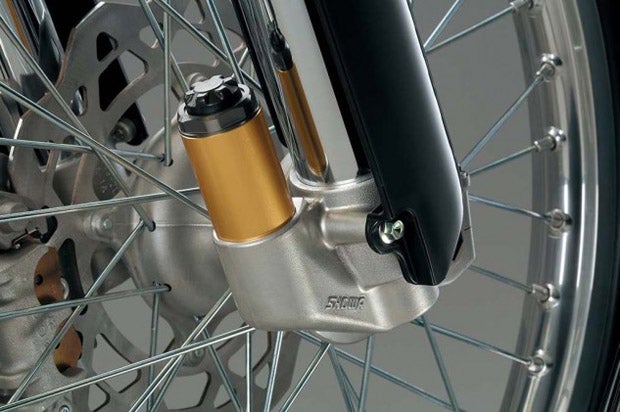
A trick new 48mm Showa SFF-Air fork is partially responsible for the RM-Z450’s improved handling. The SFF-Air replaces the previous Separate Function Fork, but the Suzuki version differs from the Honda and Kawasaki versions by virtue of the fact that its third air chamber—a.k.a. balance chamber—is external, located at the bottom of the right fork leg. Suzuki tested this version of the SFF-Air on James Stewart’s factory Yoshimura Suzuki throughout the 2014 season before pronouncing it ready for production. Like the other brands that have made the switch, Suzuki claims a 2.5-lb. weight reduction as well as more incremental adjustability as the primary factors in going spring-less up front.
The 48m SFF-Air fork is matched with a Showa Piggyback rear shock that features high/low-speed compression damping adjustability as well as rebound damping and spring preload adjustability to control its 12.2 inches of travel. Out back, a Showa piggy-back single shock absorber with high- and low-speed compression, rebound damping and spring preload adjustability also delivers 12.2 inches of travel.
During our test session, Abbatoye noted that the fork felt a little harsh initially and was riding too low. Adding pressure to the balance chamber raised the ride height and also brought the fork into better coordination with the rear suspension. After that, all it took was a slight increase to the rebound setting on the fork and its Showa piggyback reservoir shock to make the big Suzuki perfectly compliant over the whole gamut of suspension loads, including small bumps, spike hits, g-outs and everything in-between. The Suzuki’s on-track behavior proved just how much easier it can be to dial-in the suspension with an air fork—that is, provided that you have the special air pump required to make the adjustments. Rather than throw one in at the point of sale, Suzuki requires that you buy its pump as an accessory. That’s not so cool, even if the suspension itself is. In either case Abbatoye definitely liked the new Suzuki fork.
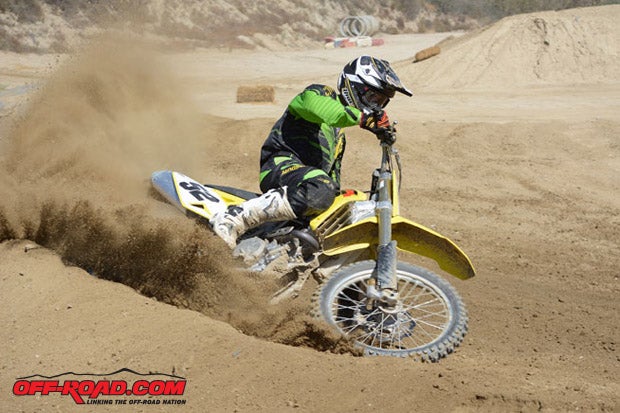
“I like them, but I am an off-road guy, and for off-road you kind haven’t been able to trust them,” Abbatoye said. “Now, with the triple chamber, at least it seems like if you lost air pressure they wouldn’t collapse. Overall, it’s just a lot more composed than the 2014 bike. Suzukis have been known for good turn-in, but with the 2014, over the fast stuff it was kind of nervous, but with the new fork and revised shock valving it is really stable.”
Adding to rider confidence is a comfortable ergonomic package that makes it easy to maneuver the RM-Z450. Perched 37.6 inches off the ground, it is flat and slim. The RM-Z’s bars are also positioned well, allowing the rider to feel comfortable when seated or standing.
At the end of the day, even though it didn’t get a big power boost for 2015, the RM-Z450 represents a huge improvement over the 2014 model. Its chassis feels better, its new suspension works better, and it may just be the best handling open-class motocross bike in the class. With an MSRP of $8749, it’s also one of the better bargains in the class. That said, we won’t be surprised to see a lot of yellow-hued bikes circulating the nation’s motocross tracks next summer, nor will we be shocked if the factory team wins another AMA Championship, or two, by the end of 2015.
2015 Suzuki RM-Z450 Specifications
MSRP: $8749
Engine Type: 449cc, 4-stroke, liquid-cooled, single cylinder, DOHC
Bore Stroke: 96.0mm (3.78 in) x 62.1mm (2.4 in)
Compression Ratio: 12.5:1
Fuel System: Keihin fuel injection w/44mm throttle body
Starter: Primary kick
Lubrication: Semi-dry sump
Ignition: Electronic ignition (CDI)
Transmission: 5-speed constant mesh
Final Drive: Chain, DID520MXV4, 114 links
Horsepower (rear-wheel): 49.5 @ 8750 rpm
Torque: 31.53 @ 8000 rpm
Overall Length: 2190 mm (86.2 in.)
Overall Width: 830 mm (32.7 in.)
Overall Height: 1270 mm (50.0 in.)
Wheelbase: 1495 mm (58.9 in.)
Ground Clearance: 325 mm (12.8 in.)
Seat Height: 955 mm (37.6 in.)
Claimed Curb Weight: 112 kg (247 lbs.)
Weight (as tested): 248.0 lbs., 119 lbs. (front)/129 lbs. (rear); 48%/52%
Suspension Front: 48mm Show SFF-Air inverted telescopic fork, fully adjustable, 12.2 inches of travel
Suspension Rear: Link type w/Showa piggyback reservoir shock, fully adjustable, 12.2 inches of travel
Brakes Front: 250mm disc brake w/twin-piston caliper
Brakes Rear: 240mm disc brake w/single-piston caliper
Tires Front: Bridgestone M403, 80/100-21 51M, tube type
Tires Rear: Bridgetone M404, 110/90-19 62M, tube type
Fuel Tank Capacity: 6.2 L (1.6 US gallons)
Color: Champion Yellow/Solid Black


 Your Privacy Choices
Your Privacy Choices